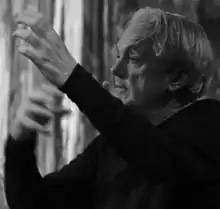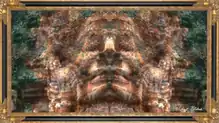Robert Blalack
Robert Blalack is a mass-media visual artist and producer. One of the founders of Industrial Light & Magic,[2] he received the Visual Effects Academy Award for his work on the original Star Wars. He also received the Visual Effects Emmy for his work on the television motion picture The Day After. He produces and directs USA and international mixed-media TV commercials, location-based theme park rides, and his independent, experimental feature films.
Robert Blalack | |
|---|---|
 Robert Blalack delivering a multi-media conversation at the Cinematheque Francaise on June 12, 2015 | |
| Nationality | USA |
| Alma mater | Pomona College[1] California Institute of the Arts |
| Occupation | Film director, producer, writer, Visual effects supervisor |
| Years active | 1969 - present |
Notable work | Star Wars - The Day After - Cosmos: A Personal Voyage. |
Education
- St. Paul's School, London, England 1963-1966. University Entrance A Levels: Physics, Math, and Chemistry.
- Pomona College, Clairmont, California 1966-1970. BA-English Literature/Theater Arts. Begins self-taught work in non-narrative experimental film.
- California Institute of the Arts 1970-1973. MFA-Film Studies. Continues experimental film work, co-directs The Words (1973) with Cal-Arts professor Don Levy. Blalack is the teaching assistant of experimental filmmaker and faculty member Pat O’Neil.
Career
Early experimental films
- Over/Done (1969) 24 minutes
- If They Only Knew (1969) 20 minutes
- Navajo Mountain (1972) 36 minutes
- The Words (1973) 26 minutes.
Early professional career
1973: Blalack works the optical printer night shift making 35mm to 16mm TV negatives at Crest Film Labs, later renamed Crest Digital.
- Hearts And Minds (1974). Academy Award recipient for Best Documentary Feature. Blalack animates director Peter Davis´s smuggled photographs of Con Son Island Tiger Cage prisoners.[3]
- One By One (1975). Blalack creates a first-person subjective optical effects sequence designed to put the audience in the driver's seat of a Formula One race car.[4]
During Blalack's work for One By One, Praxis Film Works, Inc. is formed. After One By One, Blalack continues to produce optical effects for low-budget Hollywood movies and optical composite for high-end TV commercials.[5][6]
In 1975, Blalack works with the two leading Visual Effects innovators, Robert Abel and Douglas Trumbull.[7] Trumbull commissions Blalack to make a 16mm promo showcasing the creativity of Trumbull's Visual Effects studio “Future General”. While making this documentary, Blalack meets Trumbull's cameraman John Dykstra.
Star Wars (1975-77)
In June 1975, George Lucas chooses John Dykstra to supervise the Visual Effects for Star Wars. Dykstra asks Blalack to help him build the Star Wars VistaVision Visual Effects facility. As one of the founders of Industrial Light & Magic, Blalack's responsity is to create crucial ILM VistaVision Photographic Optical Composite and Rotoscope Animation production pipelines that will mass-produce a record 365 VistaVision-to-35mm Panavision anamorphic Visual Effects composites.
No modern VistaVision photographic blue screen pipeline exists when ILM is founded. The modest Budget of Star Wars dictates that Blalack gather obsolete VistaVision optical composite equipment, modernize and debug each mechanical and optical component, devise methods to mass-produce 365 Visual Effects composites, design the Rotoscope Department, and hire and train the Optical Composite and Rotoscope crew. Blalack supervises the design and fabrication of the world's first and only aerial-image diffraction-limited VistaVision-to-35mm optical composite system. The Star Wars 365 VistaVision Visual Effects shots contain 1,250 original VistaVision color negative elements, from which are generated more than 10,000 RGB Black & White Color Separations, mattes and other intermediate VistaVision composite elements. All of these VistaVision Visual Effects composite elements are photographed and composited during the final seven months of the Star Wars production.[8]
At the Star Wars 40th anniversary, Blalack spoke to the assembled crew: “All of us changed the direction of filmmaking. Because of you, visions once completely impossible are now within reach. And you know it wasn’t always like that. We discovered that building ILM from scratch during production was like jumping out of a low-budget airplane, and stitching up a parachute during freefall.”[2]
Star Wars Academy Award (1978)
Blalack receives the 1978 Best Visual Effects Academy Award for his work on Star Wars.[9]
Cosmos: A Personal Voyage
In 1980 Blalack produces Visual Effects for 12 of the 13 episodes of Carl Sagan's Cosmos: A Personal Voyage, in collaboration with the series producer Adrian Malone.[10][11]
The Day After
In 1983, Blalack designs and produces The Day After visual effects. To determine what Visual Effects the movie needs, the Praxis team creates storyboards designed to visualize the effects on the population of Lawrence, Kansas of the nuclear detonations, the blasts aftermath, radiation effects, and the missile contrails of US-launched ICBMs.[12]
Praxis analyzes the cost of 35mm high-speed blue screen photography of real explosions designed to simulate a nuclear bomb mushroom cloud. Given the number of shots with unique mushroom clouds that must be produced within the modest production budget, Blalack decides to create both the nuclear bomb simulations and the missile contrails of the US-launched ICBMs in a Praxis Film Works, Inc. custom-built, computer-controlled water tank, where the interaction between the iconic mushroom cloud “cap” and “stem”, are each separately controlled with precision.[13][14]
The Day After Emmy (1984)
Blalack receives the 1984 Outstanding Individual Achievement, Special Visual Effects Emmy for his work on The Day After.[15][16]
Additional motion picture work
Blalack creates and produces visual effects for motion pictures, including:
- Blues Brothers (1980). Works with director John Landis and producer Robert Weiss to design and produce the visual effects for the “Nazis Drive off the End of the Unfinished Freeway” sequence.[17][18]
- Airplane! (1980). Produces the iconic opening sequence of the tail fin of a passenger jet swimming back and forth through clouds, set to the theme music from Jaws.[19][20]
- Altered States (1980). Works with director Ken Russell to design and produce special optical effects sequences simulating the psychedelic effects experienced by William Hurt's character.[21]
- Wolfen (1981). Works with Academy Award winner Michael Wadleigh to design and produce the “Wolf Vision” Special Visual Effects. Wolf Vision incorporates multi-layered RGB color separation optical composites of the Wolfen POV cinematography shot by Steadicam inventor Garret Brown.[22]
- Cat People (1982). Works with director Paul Schrader to design and produce the CatVision of Natasha Kinski's character after she transforms into a black panther.[23][24]
- RoboCop (1987). Works as Optical Supervisor with director Paul Verhoeven and producer Jon Davison.[25]
Theme park work
- Seafari (1994). Praxis Film Works, Inc. produces Motion Control Miniature Photography for Rhythm & Hues´s mixed-media theme park ride, with lighting by Visual Effects Oscar winner Alex Funke.
- Aliens: Ride at the Speed of Fright (1996). Praxis Film Works, Inc. provides Motion Control Miniature Photography for this Iwerks Entertainment Location-Based theme park ride, that explores visual themes from the movie Aliens.[26]
- Akbar’s Adventure Tours - Busch Entertainment, Inc. (1998). Blalack directs live action sequences in Marrakech, Morocco and Hollywood, California with Martin Short and Eugene Levy. Praxis Film Works, Inc. produces the visual effects.[27]
Television commercial work
Blalack has directed hundreds of multi-layered mixed-media USA and International TV commercials, produced by Praxis Film Works, Inc., for such clients as Cadillac, Chevrolet, Coca-Cola, Dodge, Hyundai, Kodak, Minolta, Panasonic, Papermate, Philip Morris, Union Carbide, Sharp, and 3M.[28]
Independent motion pictures
Blalack is in post production on ”Daddy Dearest”, a Praxis Film Works, Inc. production of Blalack's experimental 8K motion picture scheduled for a 2019 release.

Artworks
Blalack's “Living Paintings” are 10 hour 4K and 8K UHDTV artworks created from his 2008 to 2017 photographic journeys into the ancient temples of Angkor Wat, China, India, Sri Lanka, and the Gothic churches of France.
Multi-Media conversations
Blalack has given multi-media talks at more than 70 universities, film schools, VFX schools, art schools and film festivals in China, Germany, Austria, and in France at the Cinematheque Francaise. He explores the design and realization of ILM from scratch for Star Wars, the impact of VFX on Hollywood studio creative choices, strategies for aspiring movie workers to optimize their career paths into and inside today's Merged-Media Motion Picture design and production opportunities.
References
- "Robert Blalack". LinkedIn. Retrieved 27 August 2020.
- "We Meet Again At Last: ILM Veterans Reunite to Celebrate 40 Years of Star Wars | StarWars.com". StarWars.com. 2017-06-14. Retrieved 2017-12-16.
Remembering those early days on Star Wars, Blalack would jokingly add, “We discovered that building ILM from scratch during production was like jumping out of a plane and stitching up the parachute during free fall.”
- "Academy Awards Acceptance Speeches - Search Results | Margaret Herrick Library | Academy of Motion Picture Arts & Sciences". aaspeechesdb.oscars.org. Retrieved 2017-12-16.
- One by One (1974), retrieved 2017-12-16
- "Praxis Film Works - IMDbPro". Retrieved 2017-12-16.
- Turnock, Julie A. (2014-08-01). Plastic Reality: Special Effects, Technology, and the Emergence of 1970s Blockbuster Aesthetics. Columbia University Press. ISBN 9780231535274.
- Keil, Charlie; Whissel, Kristen (2016-08-26). Editing and Special/Visual Effects. Rutgers University Press. ISBN 9780813570839.
- "American Cinematographer: Complete Star Wars Coverage". theasc.com. Retrieved 2017-12-16.
- "The 50th Academy Awards | 1978". Oscars.org | Academy of Motion Picture Arts and Sciences. Retrieved 2017-12-16.
- Cosmos, Carl Sagan, Jaromír Hanzlík, Jonathan Fahn, retrieved 2017-12-16CS1 maint: others (link)
- Sagan, Carl (2000), Cosmos: a personal voyage. Volumen 2 (in Ndonga), Cosmos Studios, retrieved 2017-12-16
- ""Creative Realism for the Day After" by Turner, George - American Cinematographer, Vol. 65, Issue 2, February 1984 | Online Research Library: Questia". www.questia.com. Retrieved 2017-12-16.
- "Revisiting Cinefex (15): Never Say Never Again, The Day After, Ralph Hammeras". Graham Edwards. 2012-03-05. Retrieved 2017-12-16.
- Staff, Hollywood.com (2015-02-05). "The Day After | Full Cast and Credits". Hollywood.com. Retrieved 2017-12-16.
- "Robert Blalack | Television Academy". Television Academy. Retrieved 2017-12-16.
- "Nominees/Winners". Television Academy. Retrieved 2017-12-16.
- The Blues Brothers (1980), retrieved 2017-12-16
- Venkatasawmy, Rama (2013). The Digitization of Cinematic Visual Effects: Hollywood's Coming of Age. Rowman & Littlefield. ISBN 9780739176214.
- Airplane! (1980), retrieved 2017-12-16
- Clark, Mark (2015-08-01). Star Wars FAQ: Everything Left to Know About the Trilogy That Changed the Movies. Hal Leonard Corporation. ISBN 9781495046087.
- "Altered States (1980) by Ken Russell : the movie". www.ketamine.co.uk. Retrieved 2017-12-16.
- "Wolfen". TVGuide.com. Retrieved 2017-12-16.
- "Filmography for Robert Blalack". Turner Classic Movies. Retrieved 2017-12-16.
- Cat People (1982), retrieved 2017-12-16
- Staff, Hollywood.com (2015-02-05). "Robocop | Full Cast and Credits | 1987". Hollywood.com. Retrieved 2017-12-16.
- "Aliens: Ride at the Speed of Fright - Scified.com". Scified. Retrieved 2017-12-17.
- Blalack, Robert, Akbar's Adventure Tours, Martin Short, Eugene Levy, Ric Sarabia, retrieved 2017-12-17
- "Production Slate" by Rhea, Marji - American Cinematographer, Vol. 75, Issue 7, July 1994 | Online Research Library: Questia Reader". www.questia.com. Retrieved 2017-12-17.